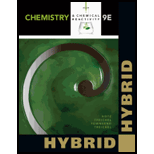
(a)
Interpretation:
The conversion of kinetic energy into potential energy or the vice versa in the given process has to be determined.
Concept introduction:
Energy:
Energy is the capacity to do work, and can neither be created nor destroyed. Generally,
Types of energy:
Kinetic energy is the energy associated with motion. Thermal energy, mechanical energy, electrical energy, and acoustic energy are categorized in kinetic energy.
Potential energy is the energy results from an object’s position or state. Gravitational energy, chemical energy, and electrostatic energy are categorized in potential energy.
(b)
Interpretation:
The conversion of kinetic energy into potential energy or the vice versa in the given has to be determined.
Concept introduction:
Energy:
Energy is the capacity to do work, and can neither be created nor destroyed. Generally, chemical reaction almost always either release or absorb energy.
Types of energy:
Kinetic energy is the energy associated with motion. Thermal energy, mechanical energy, electrical energy, and acoustic energy are categorized in kinetic energy.
Potential energy is the energy results from an object’s position or state. Gravitational energy, chemical energy, and electrostatic energy are categorized in potential energy.
(c)
Interpretation:
The conversion of kinetic energy into potential energy or the vice versa in the given has to be determined.
Concept introduction:
Energy:
Energy is the capacity to do work, and can neither be created nor destroyed. Generally, chemical reaction almost always either release or absorb energy.
Types of energy:
Kinetic energy is the energy associated with motion. Thermal energy, mechanical energy, electrical energy, and acoustic energy are categorized in kinetic energy.
Potential energy is the energy results from an object’s position or state. Gravitational energy, chemical energy, and electrostatic energy are categorized in potential energy.
(d)
Interpretation:
The conversion of kinetic energy into potential energy or the vice versa in the given has to be determined.
Concept introduction:
Energy:
Energy is the capacity to do work, and can neither be created nor destroyed. Generally, chemical reaction almost always either release or absorb energy.
Types of energy:
Kinetic energy is the energy associated with motion. Thermal energy, mechanical energy, electrical energy, and acoustic energy are categorized in kinetic energy.
Potential energy is the energy results from an object’s position or state. Gravitational energy, chemical energy, and electrostatic energy are categorized in potential energy.
Trending nowThis is a popular solution!

Chapter 1 Solutions
Chemistry & Chemical Reactivity, Hybrid Edition (with OWLv2 24-Months Printed Access Card)
- aIs the process of boiling water exothermic or endothermic with respect to the water? bA charged object is moved closer to another object that has the same charge. The energy of the system changes. Is it a change in kinetic energy or potential energy? Is the energy changes an increase or a decrease?arrow_forwardA particulate-level illustration of the reaction AB+CDAD+CB is shown below. a Identify the reactants and products in this reaction. b Is the change shown chemical or physical? c Is the mass of the product particles less than, equal to, or greater than the mass of the reactant particles? d If the reaction takes place in a container that allows no energy to enter or leave, how does the total energy in the container after the reaction compare with the total energy in the container before the reaction?arrow_forwardWhich of the following is the best example of potential energy changing to kinetic energy? a.Pushing a rock off a cliff. b.Sitting in a rocking chair. c.Observing a bird fly d.Standing on a tablearrow_forward
- What are the differentiating factors between potential and kinetic energy? a.Properties-physical or chemical b.State-solid or liquid c.Temperature-high or low d.Activity-in motion or in storagearrow_forwardIdentify the following as kinetic of potential energy examples: -Hitting a cue ball in a billiards game -A coiled spring. -Accumulated snow in a mountain -Going downhill on a bicyclearrow_forwardHow many kilocalories did the patient obtain from the lunch? Express the energy as an integer and include the appropriate unitsarrow_forward
- a 43g of chocolate has 2.10 x 102 calories. convert this energy to units of joulesarrow_forwardThe diagram on the left represents the result of a process. Which of the diagrams [(i) to (iii)]could represent the starting material if the process were physical, and which could represent the starting material if the change were chemical?arrow_forwardA book is held at a height above the floor it has certain amount of potential energy when the book is released its potential energy and converted to kinetic energy as it falls to the floor the book hits the floor and comes to rest according to the law of conservationarrow_forward
 Chemistry for Today: General, Organic, and Bioche...ChemistryISBN:9781305960060Author:Spencer L. Seager, Michael R. Slabaugh, Maren S. HansenPublisher:Cengage Learning
Chemistry for Today: General, Organic, and Bioche...ChemistryISBN:9781305960060Author:Spencer L. Seager, Michael R. Slabaugh, Maren S. HansenPublisher:Cengage Learning Introductory Chemistry: An Active Learning Approa...ChemistryISBN:9781305079250Author:Mark S. Cracolice, Ed PetersPublisher:Cengage Learning
Introductory Chemistry: An Active Learning Approa...ChemistryISBN:9781305079250Author:Mark S. Cracolice, Ed PetersPublisher:Cengage Learning Chemistry & Chemical ReactivityChemistryISBN:9781337399074Author:John C. Kotz, Paul M. Treichel, John Townsend, David TreichelPublisher:Cengage Learning
Chemistry & Chemical ReactivityChemistryISBN:9781337399074Author:John C. Kotz, Paul M. Treichel, John Townsend, David TreichelPublisher:Cengage Learning General Chemistry - Standalone book (MindTap Cour...ChemistryISBN:9781305580343Author:Steven D. Gammon, Ebbing, Darrell Ebbing, Steven D., Darrell; Gammon, Darrell Ebbing; Steven D. Gammon, Darrell D.; Gammon, Ebbing; Steven D. Gammon; DarrellPublisher:Cengage Learning
General Chemistry - Standalone book (MindTap Cour...ChemistryISBN:9781305580343Author:Steven D. Gammon, Ebbing, Darrell Ebbing, Steven D., Darrell; Gammon, Darrell Ebbing; Steven D. Gammon, Darrell D.; Gammon, Ebbing; Steven D. Gammon; DarrellPublisher:Cengage Learning World of Chemistry, 3rd editionChemistryISBN:9781133109655Author:Steven S. Zumdahl, Susan L. Zumdahl, Donald J. DeCostePublisher:Brooks / Cole / Cengage Learning
World of Chemistry, 3rd editionChemistryISBN:9781133109655Author:Steven S. Zumdahl, Susan L. Zumdahl, Donald J. DeCostePublisher:Brooks / Cole / Cengage Learning





